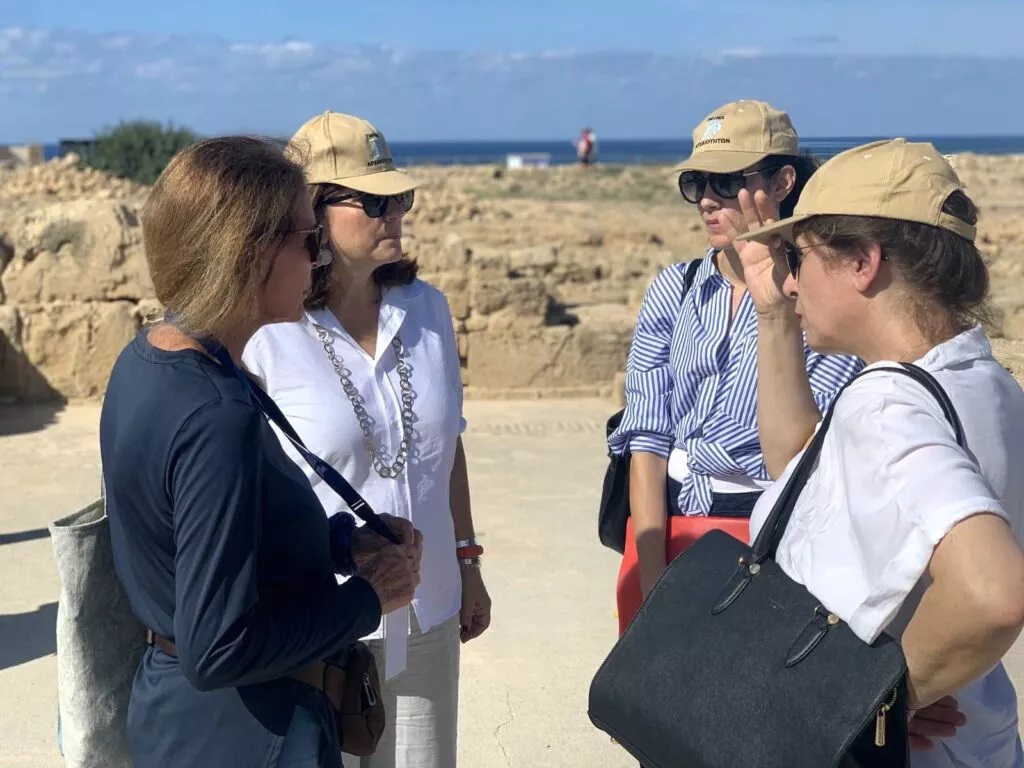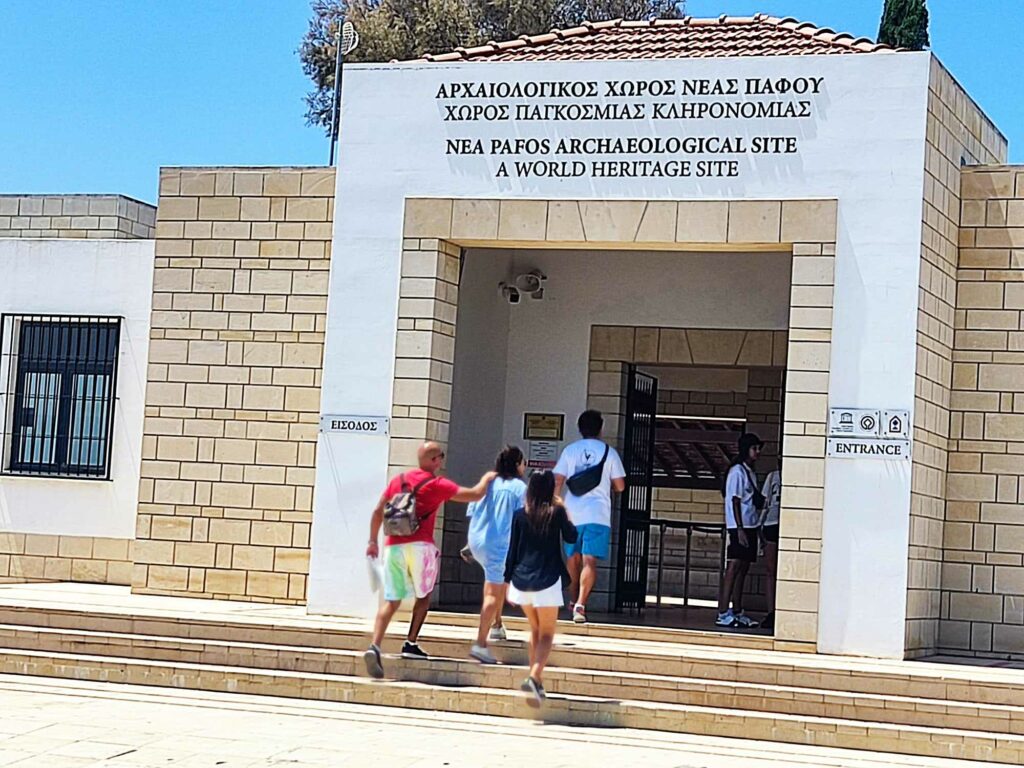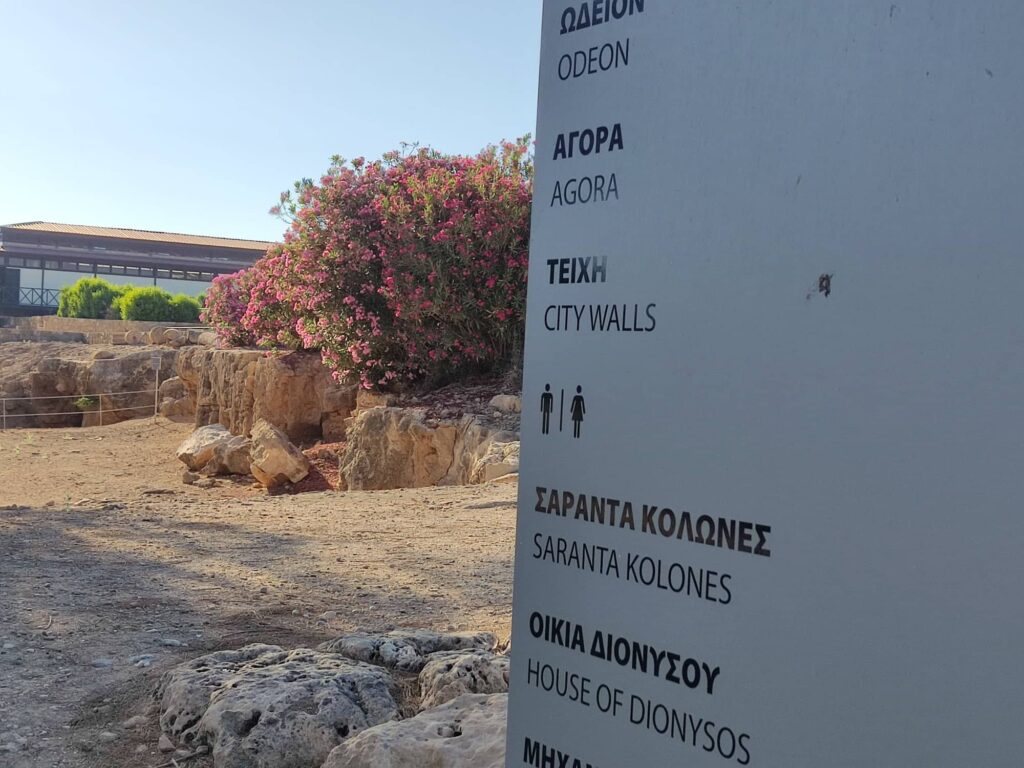Filenews 20 December 2023 - by Dora Christodoulou
The installation of special shelters for the protection of antiquities of global importance in the Archaeological Park of Kato Pafos is a project that requires special expertise, time and therefore patience. The message was sent during her recent visit to the archaeological site by the Deputy Minister of Culture, announcing that we are now ready for the second phase of the complex process, which concerns the construction of the shelters, after the completion of the relevant study.
The position of Lina Kassianidou acquires particular importance in order to allay the concerns that began to grow again in Pafos about the fate of the important project. And this, since after the joint announcements of the Department of Antiquities and the Getty Conservation Institute of the USA from the summer of 22, most bodies of the province considered that the shelters were ready to come to Pafos and therefore the passage of another year without this happening, was considered an omen of further delays.

The Department of Antiquities has been collaborating with the Getty Conservation Institute for five years for the creation of the Plan for the Conservation and Management of the Archaeological Site of Nea Pafos, which is a UNESCO World Heritage Site, the competent Deputy Minister clarified. The mosaics need protection, as most of them are exposed to weather conditions, he pointed out, clarifying that the Department of Antiquities has made huge efforts to protect them.
"But because we want them to be accessible to people, we have done this study with the aim of putting shelters in place," he said. "During the first phase of the study, an international competition sponsored by the Getty Conservation Institute has been conducted. Now we are at the stage of discussing the second phase concerning the implementation of the shelters, which I hope will be done again in part with funding from this very important institution from America."
The Deputy Minister of Culture clarified, however, that after the implementation of the study, however, the detailed design of the shelters is still pending, warning that it is expected to take some time to be implemented. The aim is to do this as quickly as possible, on the basis of the procedures that the state has, he made clear.

It is our priority to complete these procedures, concluded Mrs. Kassianidou, both because of the global importance of the archaeological treasures of Pafos, and because of the huge number of visitors to the Archaeological Park, which is by far the most visited archaeological site in Cyprus with five thousand visitors daily.
The final stretch of a pending issue that counts more than three decades, essentially marked August 2022. The Department of Antiquities and the Getty Conservation Institute of the USA, announced at the time that the tender for the construction and installation of the shelter for the protection of the mosaics of Kato Pafos had been awarded after many years of procedures, putting an end to an uncertainty that had prevailed since the 1990s. The contractor of this important specialized project, as announced, is the architectural firm Hugh Broughton Architects, selected by an international committee of experts from among six competing firms.
The competition was promoted within the framework of the Conservation and Management Plan developed by the Department of Antiquities in collaboration with the Getty Conservation Institute for the protection of this important archaeological site and mosaic floors that are unique throughout the eastern Mediterranean, as well as the rest of the remains and monuments dating back to the Hellenistic, Roman, Early Christian, Byzantine and Byzantine periods. Medieval and Ottoman period. During the elaboration of this Plan, the creation of shelters for the protection and optimal presentation of mosaic floors and archaeological remains was considered necessary and of great importance.

For the needs of the competition, the Department of Antiquities and the Getty Conservation Institute, in collaboration with scientists from abroad specializing in conservation and protective shelters for archaeological sites, created a detailed design guide that included the need to protect sensitive archaeological remains from anthropogenic and environmental threats, the importance of maintaining the relationship between the shelters and the surrounding area, The creation of the right conditions for viewing the mosaics and facilitating the movement of visitors, as well as the use of sustainable materials and systems.
In addition, this proposal is based on an understanding of the general environmental threats to mosaics, such as salt formation, and presents solutions for effective control. The individual elements of the shelter proposals, such as the roof and the use of local materials such as clay tiles, wooden elements on the walls and other places, are consistent with other existing structures in and near the archaeological site. The canopy does not compete with mosaics and other remains due to the simplicity of its design, while the proposed flexible system with footbridges allows various options for the development of visitor traffic routes. The canopies can be expanded or copied with a solution proposed by the team for the use of components with locally available materials that can be easily replaced.
According to the Department of Antiquities, the protection of the unique mosaics of the important archaeological site of Nea Pafos, which is part of the UNESCO World Heritage, has always been a priority for the department. For this reason, it is noted, it proceeded, in collaboration with the Getty Conservation Institute, to the creation of a Management Plan and an international tender for the creation of shelters that will protect sensitive archaeological remains.
"The proposal of the office of Hugh Broughton Architects", according to the Department of Antiquities, "takes into account the basic criteria set in the context of the competition, such as the preservation of the integrity of the ancient houses to be housed and the wider archaeological site, as well as various other archaeological and environmental factors and visitor issues".
According to Jeanne Marie Teutonico, Deputy Director of Strategic Institutions and Publications at the Getty Conservation Institute, designing shelters for archaeological sites is a complex process that must balance a number of conflicting requirements. The careful and creative design of Hugh Broughton Architects will help protect the mosaics with structures that are sustainable and sensitive to archaeological evidence, he said.
For his part, the head of the house that undertook the huge project, Hugh Broughton, stressed that the development of ideas for the creation of shelters for the archaeological site of Nea Pafos was a big undertaking. We have proposed solutions that minimize the physical and visual impact on space, he explained, using sustainable passive design techniques to protect these unique mosaics and architectural elements:
"Our designs reflect the creative and methodical collaboration between architects, conservators and engineers. All look forward to working with the Department of Antiquities and the Getty Conservation Institute to develop individual improvement proposals aimed at the future protection of this unique site."
The Getty is an internationally recognized organization in the field of arts, active in the field of exhibitions, as well as the preservation and understanding of the world's artistic and cultural heritage. He collaborates with institutions around the world and his work aims to understand the relationships between cultures.
The Getty Conservation Institute, with which the Department of Antiquities has collaborated for many years, focuses on the development of conservation practices for archaeological sites. It supports conservation through scientific research, education, field research and the dissemination of information, creating and offering knowledge.
